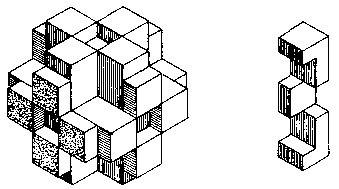
[Home] [Contents] [Figures] [Search] [Help]
[Next Page] [Prev Page] [ Next Chapter] [Prev Chapter]
There is one other symmetrical 12-piece burr that is a classic and quite unlike any of the others mentioned thus far. It is shown assembled in Fig. 75a, together with one of its 12 pieces, all of which are identical. US Patent No. 430,502 was granted to William Altekruse in 1890 for this puzzle. The puzzle has been popular for a long time and manufactured in many different forms with many different names (except Altekruse). The Altekruse family is of Austrian-German origin. Curiously, the name means "old cross" in German, which has led some authors to incorrectly assume that it was a pseudonym. A William Altekruse who is presumed to be the grantee of the patent came to America as a young man in 1844 with his three brothers to escape being drafted into the German army. Could he have brought at least the germ of the idea with him? Whatever the case, it is a most interesting burr. By the way, note that if one insists on being precise, it is not quite symmetrical visually because the asymmetrical notch arrangements reveal themselves.
Fig. 75a
The Altekruse Puzzle, sometimes known as the 12-piece burr, has an unusual mechanical action in the first step of disassembly by which two halves move in opposition to each other. This may come as quite a surprise to those accustomed to the more familiar burr types with a key piece or pieces. Depending upon how it is assembled, this action can take place along one, two, or all three axes independently but not simultaneously. If two extra pieces are available, there is a surprising 14-piece solution shown in Fig. 75b. It was made from mahogany by Tom Lensch.
Fig. 75b
| ©1990-2005 by Stewart T. Coffin For questions or comments regarding this site, contact the chief metagrobologist: |
[Next Page] [Prev Page] [ Next Chapter] [Prev Chapter]